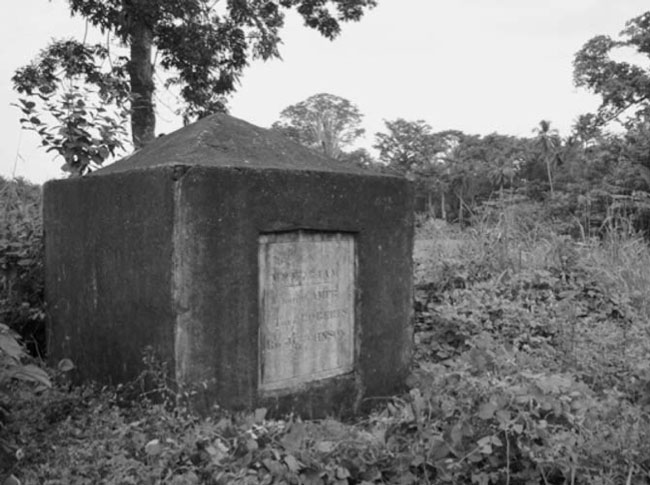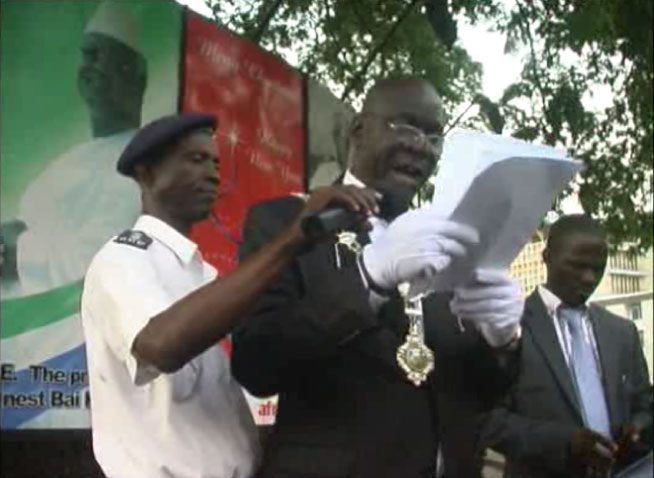| Foundation | Reference |
|---|---|
| Purpose | Godly nations governed according to Kingdom principles ‘…spiritual war is for the sake of the nations; the disciples were sent to make the nations disciple-nations under Jesus. So first of all: Is the Church aware of this primary task?’[1] |
| Precept | ‘If the foundations be destroyed, what can the righteous do?’ Ps 11:3. |
| Precedent | Abraham and Israel covenant. |
| Practice | Sierra Leone laid a godly foundation and its people and land flourished. Sierra Leone laid another, ungodly foundation, and its people and land floundered. |
| Pattern | Ungodly foundation leads to a troubled nation. Godly foundation leads to a peaceful and prosperous nation. Revelation; Repentance; Reconciliation; Restoration |
‘Without salvation from sin there is no salvation from “evil powers” either.’ Keith Ferdinando[2]
Overview
The collapse of the Twin Towers on 11 September 2001 with the loss of over 5,000 lives was not a problem with their foundations. It was directly attributed to the impact of the aircraft.
Nations flounder or flourish ultimately based on the spiritual strength of their foundations: either sandy and shifting, or concrete and stable.
However, the real, albeit indirect, cause of the physical collapse was non-physical. It was the failure of security systems that would have prevented the attack in the first place. Nations may not collapse as dramatically as the Twin Towers. However, nations flounder or flourish ultimately based on the spiritual strength of their foundations: either sandy and shifting, or concrete and stable.
Sierra Leone illustrates the often forgotten role foundations play in determining the fortunes of a nation. Sierra Leone pioneered Christianity, commerce, and civilization in colonial Africa. The freed slaves—later known as Creoles—who made their way across the Atlantic from Nova Scotia with the help of the Clapham Sect in London were Christians who saw themselves as Israelites delivered from slavery in Egypt. Upon landing on 11 March 1792 they founded Free Town, Sierra Leone, and dedicated it by covenant to God.
Sierra Leone flourished as a beacon of light for over 150 years, famously known as the ‘Athens of Africa’ for pioneering the first university and secondary schools in sub-Saharan Africa: Fourah Bay College in 1827, the Grammar School in 1845, and the Annie Walsh school for girls in 1849, established with the help of the Church Mission Society.
However, Sierra Leone’s fortunes collapsed very quickly, after laying ungodly or idolatrous foundations at independence on 27 April 1961. It slid from prosperity to dirt-poverty, in the midst of abundant resources, coupled with multiple catastrophes, such as war, pestilence, poverty, and disasters.
Mercifully, in 2014, the church began to come to an understanding of Sierra Leone’s bloody April 27th foundations and commenced the process of redeeming the land, with encouraging results. This piece focuses on Sierra Leone’s destabilizing faulty foundation and lessons learnt.
The good news is that there are clear biblical principles, precepts, and precedents underpinning the Sierra Leone experience, from which the church in other nations can learn. This will enable them both to undress and address hidden roots of foundational problems that frustrate their national efforts at sustainable advancement.

The April 27th massacre
A massacre was launched on 27 April 1898 in the south of the British Protectorate of Sierra Leone, later known as the ‘Hut Tax War’. The war boys of the dreaded Poro secret society rose up all over Mende land in a surprise attack on missionaries and Christians (Creoles), aligned to the British. Charles Braithwaite Wallis helpfully records:
One of the worst murders that took place during the whole outbreak was the killing of Mr. T. Johnson and his sister, a girl of eighteen, who were caught hiding in a village called Deparli, in the Jong country. They were tied together, stripped naked, and terribly flogged. They were then made to walk to Tihun in the Small Boom country, several hours’ journey away, where they were brought before the chief, a man named Vandi, who immediately ordered them to be killed. They were then flogged again in the presence of a large number of people, and had to walk back, in the charge of a party of war boys, to Deparli. When they arrived there, the war boys tied Johnson to one tree, and his sister to another, both in view of each other. A man then appeared with a knife, and after some difficulty succeeded in cutting of one of Johnson’s ears. Miss Johnson’s ear was also cut off. Then several ruffians held first one, and then the other, down and slit their tongues. In this position they were left for some hours, and then conveyed into the bush and flung into a fire which was made ready to receive them. Whether they were dead or not when this happened I could not ascertain. Let us hope they were. There were three other murders committed in or near this village of Deparli, and the perpetrators of them have unfortunately never been caught.[3]
So horrendous was this April 27th massacre of over 2,000 Creoles and missionaries that on 18 June 1898, Queen Victoria commissioned an enquiry into ‘an insurrection of the Natives of our Protectorate . . . accompanied by murders of and outrages upon our subjects and other persons.’[4]
Laying the foundation
Strikingly, the descendants of the perpetrators of the massacre chose 27 April to inaugurate the Sierra Leone People’s Party (SLPP) in 1951. Ten years later in 1961 at independence, the ruling SLPP party chose the same date for the British to hand Sierra Leone over to them. It seemed that overnight the worship of God was erased from the governance and socio-economic life of this fledgling nation. On the eve of independence, some 1,200 masked devils descended on Freetown in a ritual victory parade. This is repeated every Independence Day, with devil masquerades replacing thanksgiving in all the major towns of Sierra Leone—but not without dire consequences. As Habakkuk says: ‘Woe to him who builds a town with bloodshed, who establishes a city by iniquity’ (Hab 2:12). Sierra Leone has indeed seen more than its share of woes.

Consequences
From the slaughter of righteous Abel, judgment has always responded to the cry of unjust bloodshed; and, ‘precious in the sight of the Lord is the death of his saints’ (Ps 116:15).
Idolatry and devil worship also attract sorrows, according to the Bible. For, ‘their sorrows shall be multiplied that hasten after another god’ (Ps 16:4). Indeed, divine judgement seems to be manifest in three main forms according to Jeremiah: ‘I will consume them by the sword, and by the famine, and by the pestilence’ (Jer 14:12); and Sierra Leone has witnessed all three to devastating effect.
Judgement of famine—1980 fiscal collapse
In spite of being one of the richest nations in terms of natural resources (from minerals to marine and agricultural produce), Sierra Leone is always trailing among the poorest. From an economy the size of Malaysia and Singapore combined in the 1960s, it now rates third from bottom in the Global Hunger Index, a Harvard-based monitor. Lebanese and Chinese businesses are consuming its abundant gold, diamonds, iron ore, and rutile, with little benefit to the nation. In 1964, the Leone was higher in value than the pound sterling. Today, there are over Le9,000 to the pound.
Judgment of the sword—1991 – 2002 war
Over 50,000 Sierra Leoneans perished in the senseless but barbaric eleven-year war. Infrastructure was destroyed and near-anarchy prevailed. It provoked the biggest UN peace-keeping mission in history.
Judgment of pestilence—Ebola epidemic 2014 – 2015
On 25 May 2014, Ebola struck Sierra Leone, paralyzing the country for almost a year. The conservative official death toll reached almost 4,000; and many more survivors remain scarred for life.
Dealing with evil foundations: Practical lessons from Sierra Leone
Many Christians in Sierra Leone believe that before God will redeem Sierra Leone from its struggles, Christians must first come together to confront the ‘marine kingdom’.[5] The marine kingdom is a reference to the powerful spirit forces believed to operate in rivers, lakes, and the oceans. They are the source of power wielded by secret societies—‘Mermaids’, or the ‘Queen of the coast’ (Mammy wata) culture.[6]
Revelation: God reveals to redeem.
After much soul searching, research, and prayer, the truth of Sierra Leone’s predicament seemed to become clear to us; and it is our belief that it has to do with the spiritual contest signified by the March 11th covenant (see below), and the bloody April 27th foundation.
Repentance: When righteous blood is shed, it always carries grave consequences.
We draw encouragement from the experience of the church in Fiji, documented in the film ‘Fiji Transformation’. There the church underwent—en masse—repentance for the slaughter and cannibalizing of a white missionary by Fijians more than a century earlier. The people believe that revival of fortunes became possible once the curse over Fiji was lifted through repentance.
Among much else, a notable ceremony of repentance and rededication on the 222nd anniversary of the Sierra Leone Covenant was held on 11 March 2014. It attracted key dignitaries, including ministers of the state and of the church. An excerpt from Freetown’s Mayor Sam F. Bode Gibson’s prepared proclamation reads:
We have today repented of our erring ways that saw us slide from the top to the bottom of the human development indicator. We fell from a people of enlightenment, a nation of teachers, now reduced to a people of ignorance, illiterates, in need of teachers. Our Grace has turned to grass. Our sweet has turned to sour. Our light has turned to darkness. Reduced to a valley of dry bones . . . . We proclaim divine judgement on all forms of idolatry! We proclaim this an annual pilgrimage to renew this covenant of the land with the Most High![7]

Restoring righteous foundations.
Last year, for the first time, on the April 27th anniversary, the church took to the streets of Freetown and elsewhere in a prophetic praise and prayer march. This represented a turning point for the country, since even on Christian holidays such as Easter street festivals there are ‘devil masquerades’. Through the coordinating role of the Intercessors for Sierra Leone (IFSL), spearheaded by the School of the Apostles and Prophets (SOAP), and in collaboration with the body of Christ and state authorities, several activities to seek reclamation of the land have taken place. These include:
- Nationally coordinated prayer and fasting.
- Prophetic operations against idolatrous cults and devil masquerades in which Parliament, State House, and the judiciary are all implicated.
- Teaching pastors and intercessors on the March 11th covenant and the faulty April 27th foundation: training them to take dominion over occult forces in mountains and rivers.

Conclusion
Like Sierra Leone, many nations are tottering on ungodly foundations. Experts struggle to contain the physical effects—crime, corruption, violence, vice, and poverty—of spiritual causes. Only Christians can begin the work of discipling their nation, by tracing and redeeming the root cause—rotting foundations. It is this awareness that this piece hopes to bring.
Endnotes
- Pieter Bos, The Nations Called (Sovereign World, 2002), 314.
- Keith Ferdinando, The Triumph of Christ in African Perspective: A Study of Demonology and Redemption in the African Context (Carlisle: Paternoster, 1999), 397.
- Charles Braithwaite Wallis, The Advance of Our West African Empire (London: TF Unwin, 1903), 139-40.
- See ‘Report by Her Majesty’s Commissioner and Correspondence on the Subject of the Insurrection in the Sierra Leone Protectorate, 1898’ (London: Darling & Son, 1899), 3.
- Editor’s Note: No source cited for this quotation.
- For similar descriptions in ancient biblical culture, see Psalm 74:13-15.
- Editor’s Note: No source cited for this quotation.
